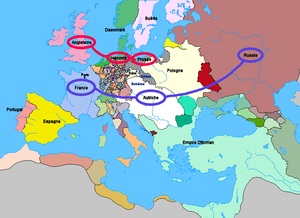Revolusi Diplomatik
Penampilan

Revolusi Diplomatik 1756 merupakan pembalikan perikatan yang lama di Eropah antara Perang Rebut Takhta Austria dan Perang Tujuh Tahun.[1] Austria pergi dari sekutu Britain kepada sekutu Perancis, manakala Prusia menjadi sekutu Britain.[2] Diplomat paling berpengaruh yang terlibat ialah negarawan Austria, Wenzel Anton von Kaunitz.[3]
Perubahan tersebut sebahagian daripada kuadril megah, corak perikatan yang sentiasa beranjak sepanjang abad ke-18 dalam usaha memelihara atau mengganggu imbangan kuasa Eropah.
Lihat juga
[sunting | sunting sumber]Rujukan
[sunting | sunting sumber]Nota
[sunting | sunting sumber]- ^ D.B. Horn, "The Diplomatic Revolution" in J.O. Lindsay, ed., The New Cambridge Modern History vol. 7, The Old Regime: 1713–63 (1957): pp 449–64.
- ^ Jeremy Black, Essay and Reflection: On the 'Old System' and the Diplomatic Revolution' of the Eighteenth Century" International History Review (1990) 12#2 pp. 301–323
- ^ Franz A.J. Szabo, "Prince Kaunitz and the Balance of Power." International History Review 1#3 (1979): 399–408. in JSTOR
Bacaan lanjut
[sunting | sunting sumber]- Black, Jeremy. "Essay and Reflection: On the 'Old System' and the Diplomatic Revolution' of the Eighteenth Century" International History Review (1990) 12#2 pp. 301–323 in JSTOR
- Coffin, Judith G. and Robert C. Stacy, Western Civilizations Volume II (2005), 568–570.
- Cooper, Kirsten. "A Rivalry Ended? France and Austria during the Diplomatic Revolution and Seven Years War, 1756–1758" (PhD. Diss. Emory University, 2012) online[pautan mati kekal].
- Horn, D. B. "The Diplomatic Revolution" in J.O. Lindsay, ed., The New Cambridge Modern History vol. 7, The Old Regime: 1713–63 (1957): pp 449–64; comprehensive brief overview.
- Ingrao, Charles W. The Habsburg Monarchy (Cambridge University Press, 2000), 157–177.
- Schweizer, Karl W. War, Politics, and Diplomacy: The Anglo-Prussian Alliance, 1756–1763 (University Press of Amer, 1991).
- Szabo, Franz A.J. "Prince Kaunitz and the Balance of Power." International History Review 1#3 (1979): 399–408. in JSTOR
